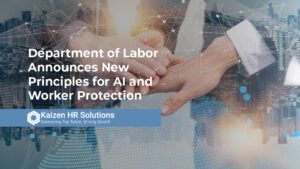Dads in the Workplace: The State of Paternity Benefits
Much-needed conversations about parental leave and family benefits extend to new dads, who often are out of the spotlight when it comes to talking about these issues in the workplace. Paternity benefits may not be talked about as much, but it turns out that offering strong benefits to all new parents leads to better results for everyone.
Where Are Paternity Benefits Now?
Paternity benefits, like other parental benefits, vary widely from place to place and from company to company – and even from individual role to role. In general, however, parental benefits are still not at the place where many parents would like them to be, and the challenges of the COVID-19 pandemic have only exacerbated the situation for a number of parents.
As of 2022, only ten states in the U.S. (plus the District of Columbia) have enacted laws addressing paid parental leave.[1] For parents outside of those areas, they may be forced to either hope that their company has voluntarily implemented strong family leave policies, or rely on the federal Family Medical Leave Act (FMLA). However, FMLA does not provide the kind of support that many new fathers (and families in general) need. The act only applies when strict requirements are met, including a threshold of hours worked in the year prior to taking leave and an organizational size of 50 or more employees. FMLA also does not require leave to be paid, which means that fathers who cannot afford to take unpaid leave cannot take advantage of these benefits.
While men’s use of parental leave is increasing overall, it’s still fairly minimal, and fewer than half of new fathers take advantage of all the benefits offered to them when those benefits are even available. Worldwide, 90 out of 187 countries offer statutory paid paternity leave, and 38 percent of organizations offer paid parental leave that exceeds the statutory minimums.[2] This signals that, despite efforts to make a cultural shift that supports paternity leave and broader parental/family leave, there are still plenty of obstacles keeping individuals from using the options available to them.
The Perks of Paternity Leave (And More)
Paternity leave isn’t just about the basics: research has shown the many perks of leave and other benefits when it comes to the overall health and success of families and employees, both at home and at work.
Taking leave tends to correlate with positive outcomes for family engagement and a more equitable division of labor at home. According to one study on the effects of paternity leave on family relationships, “Paternity leave-taking may encourage, and represent commitments to, more egalitarian arrangements by allowing men to be engaged fathers. Leave, especially extended periods of leave, provides men with time to participate in childcare and housework tasks that are traditionally performed by mothers, helps partners learn how to share tasks, and establishes expectations for a more equitable division of labor.”[3] In short: the availability and use of paternity benefits help create long-term stability and satisfaction within the family unit.
Paternity leave also leads to positive outcomes for the children whose birth is the impetus for the leave-taking. In 2019, a study found that, even as late as nine years after the initial taking of paternity leave, children whose fathers took at least two weeks of leave reported feeling closer to their fathers than the children of fathers who did not take leave.[4]
Paternity Benefits Help Partners Too
When it comes to reaping the rewards of paternity leave, the whole family benefits, including partners. Increased use of paternity leave and related benefits have been found to improve emotional, physical, and relational outcomes for mothers as well. For instance, the Institute for Labour Market Policy Evaluation found that mothers’ incomes rose 6.7% for each month that a father spent home on paternity leave, helping to offset the frequent negative career impacts that motherhood has on women’s careers.[5]
Taking paternity leave provides major benefits to the relationship between the new parents, as well. The study by Petts et al. revealed that “increased participation by fathers in childcare and other domestic work likely increases (especially mothers’) satisfaction with the division of labor and decreases (especially mothers’) parenting stress.” Additionally, couples in which the father takes paternity leave were found to have a 26% lower chance of splitting up than couples in which the father does not take leave.[6]
Paternity benefits can even provide physical and mental health benefits to new mothers. A 2019 Swedish study found that one way to improve maternal outcomes is actually to provide better paternity leave. For new mothers whose (male) partners take paternity leave, the study found that, in the first six months postpartum, there was a 26 percent decrease in anti-anxiety prescriptions, a 14 percent reduction in hospitalizations or visits to a specialist, and an 11 percent decrease in antibiotic prescriptions.[7] The key, the study found, wasn’t just in the basic number of days offered, but in the flexibility to take them as needed in order to help the new mother and child.
What Can Companies Do?
Because paternity benefits are still in flux and not standardized, it’s often up to individual companies to develop the best possible benefits for their employees. Leading the way in this regard can have enormous benefits in recruiting and retaining top talent, and it can help companies stand out in a challenging labor market.
Flexibility is key when putting together paternity leave benefits. As the research shows, it’s not just about the actual number of leave days, but about wider opportunities for flexibility, whether that means stretches of leave, paid days off here and there, or even flexible work-from-home and hybrid arrangements. Similarly, providing benefits other than just days off (WFH options, certainly, but also benefits like childcare support or educational resources) makes a big difference.
Ultimately, it’s also a matter of culture. Significant paternity leave still is not the norm for many companies and many communities, and the whole family suffers when that is the case. Instead, focus on creating a culture where taking leave and finding a good work-life balance is the norm and is, indeed, celebrated. By tackling the obstacles that prevent fathers from taking leave and being there for their families, companies can earn a lot of respect and loyalty while investing in the long-term futures of their employees.
By Rose Dorta

Are you a high-performing leader or believe you have the potential to tackle a more challenging role? Would you be interested in career opportunities that are seeking these attributes?
I’d love to chat with you and answer any questions that you have. Email me, Rose Dorta, managing director of Kaizen HR Solutions, here.
—
[1] “State Family and Medical Leave Laws.” National Conference of State Legislatures, 29 April 2022, https://www.ncsl.org/research/labor-and-employment/state-family-and-medical-leave-laws.aspx.
[2] “A fresh look at paternity leave: Why the benefits extend beyond the personal.” McKinsey & Company, 5 March 2021, https://www.mckinsey.com/business-functions/people-and-organizational-performance/our-insights/a-fresh-look-at-paternity-leave-why-the-benefits-extend-beyond-the-personal.
[3] Petts, Richard J., et al. “If I [Take] Leave, Will You Stay? Paternity Leave and Relationship Stability.” J Soc Policy. Oct. 2020, 49(4), https://www.ncbi.nlm.nih.gov/pmc/articles/PMC7575042/.
[4] Popper, Nathaniel. “Paternity Leave Has Long-Lasting Benefits. So Why Don’t More American Men Take It?.” The New York Times, 17 April 2020, https://www.nytimes.com/2020/04/17/parenting/paternity-leave.html.
[5] Johansson, Elly-Ann. “The effect of own and spousal parental leave on earnings.” Institute for Labour Market Policy Evaluation, 2010, https://www.ifau.se/globalassets/pdf/se/2010/wp10-4-the-effect-of-own-and-spousal-parental-leave-on-earnings.pdf.
[6] Petts et al., ibid.
[7] Persson, Petra, and Maya Rossin-Slater. When Dad Can Stay Home: Fathers’ Workplace Flexibility and Maternal Health.” National Bureau of Economic Research, Oct. 2019, https://www.nber.org/system/files/working_papers/w25902/w25902.pdf.







